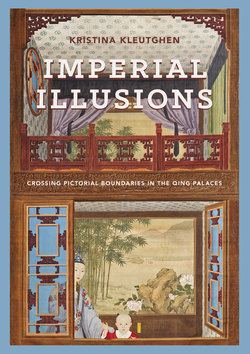Читать книгу Imperial Illusions - Kristina Kleutghen - Страница 56
На сайте Литреса книга снята с продажи.
Оглавлениеorthogonal of the bank to terminate at the small structure in the distance below the poem; and the visible horizon line, which also serves to leave the top right corner of the image blank to accommodate the original Southern Song poem within the image (the imperial poem is inscribed at the top, outside the image). The hand-tinted figures are slightly modeled through postprinting hand coloring, with darker, more saturated pigments in the same tone applied to folds in robes and darker flesh tones at the edges of faces, arms, and other body parts, leaving the rounded parts closest to the viewer only lightly or even entirely uncolored to create the impression of a highlight by modeling with color rather than line. None of the individual images in the Pictures of Tilling and Weaving employ a central vanishing point, relying instead on diagonal recession and size constancy to create their sense of depth. However, when two prints that recede in opposite directions are paired in the album, as happens in several instances (including this image and the one that follows it), the effect created by the pair is startlingly similar to a single central vanishing point located along the center binding of the album.
Jiao’s use of European pictorial techniques has sometimes been linked with the possibility that he converted to Christianity,75 although the case of Wu Li demonstrates that conversion was not necessarily accompanied by wholesale acceptance of foreign representational methods. Naturally, Jiao also incorporated Chinese pictorial elements into the print series: in this image, the ground plane tilts distinctly upward to occupy the vast majority of the picture plane; neither cast shadows nor dark shading are used for modeling; the rock forms are given volume and mass through simplified versions of traditional landscape painting texture strokes; and the sharp diagonal recession off the side of the image recalls jiehua as much as perspectival painting. This earliest extant Qing court work employing both Chinese and European techniques does not privilege one over the other, but integrates the imported ideas with Chinese representational traditions into images with greater depth, detail, and realism that serve the Kangxi emperor’s self- presentation as a legitimate, powerful emperor controlling a prosperous, well-ordered empire. Not everyone was convinced by Jiao’s work, however, and responses to European styles continued to emphasize their commonalities with artisan painting, even in the case of artists who enjoyed court appointments. The literatus Zhang Geng (1685–1760) said that Jiao’s works did not “correspond to elegant taste. Connoisseurs [literally ‘those who admire antiquity’] do not accept it.”76 It is tempting to wonder whether Zhang was not also making a coded statement about accepting Kangxi and the Qing, given the newness of Manchu rule.
Although Jiao produced the prints in 1696, the power of linear perspective and its accompanying illusionistic depth cues to deceive the viewer had been established at the Kangxi court around 1667, when the Italian Jesuit astronomer-mathematician Ludovico Buglio (Li Leisi, 1606–82) displayed three large perspectival paintings depicting a Chinese palace, a European palace, and a garden as part of a much larger Jesuit demonstration of optics for Kangxi. Verbiest’s account of this episode is the first Jesuit record of the Chinese
